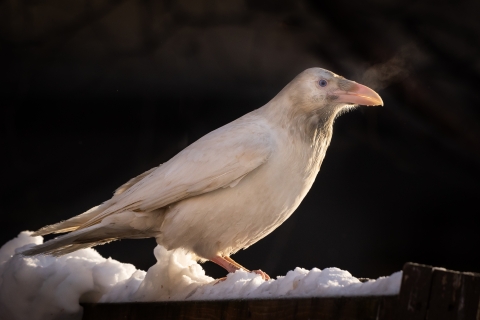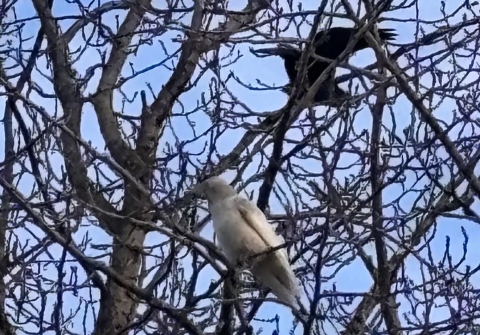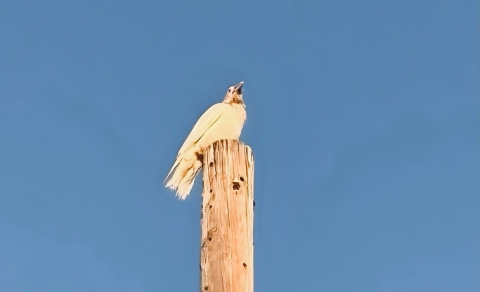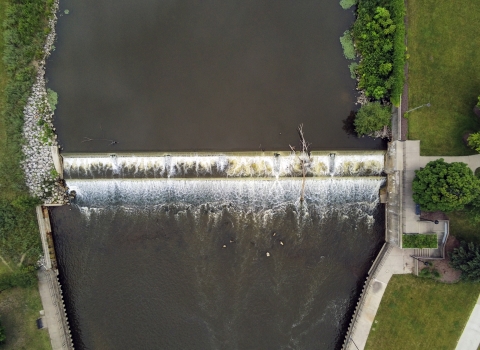A new resident moved to Anchorage in the fall of 2023 and has become quite the celebrity around town. This patron has quite a unique look and rare style that doesn’t come around very often. They (we're unsure of the sex without a blood test, or once they reach sexual maturity at age 3-4 years of age) have gathered such popularity that paparazzi follow them wherever they go. In addition to inspiring art, multiple local and national news articles, social media posts, pages, and photos have sprung up, cementing them to celebrity status.
Corvus considered
I am speaking, of course, of Corvus corax (common raven) but not the more common dark-winged passerines that perch on fast food restaurant signs or telephone lines. This ivory-colored flying curiosity is thought to have leucism (pronounced "luke-ism").
Leucism is a condition that results from a loss of pigmentation due to an absence of cells that produce melanin; this condition is sometimes confused with albinism, which is a genetic mutation where the animal is born without the enzyme essential to produce melanin. While animals with albinism usually have pink or reddish eyes, our local snowy luminary sports ocean blue peepers and consensus has diagnosed them as Leucistic. A bird has a roughly 1 in 30,000 chance of being born with the condition. This makes the White Raven a true oddity of the sky and worthy of the pomp and circumstance shown to them.
What, though, is the meaning of such a creature? We live in a city where we see ravens every day. What is different now that brings the White Raven here?
While I try to be pragmatic and hold onto reality, I don’t easily believe the supernatural or otherworldly side of things. Still, the experience of seeing them left me feeling awed and odd when I first saw the White Raven in person.
They were across a field in a tree. I was standing in a group of photographers with huge shotgun lenses on their cameras and a few other gawkers. We murmured to each other about how beautiful the creature was and how special it was to see them. With frozen feet and fingers, I shivered in my thin hoodie and stood in the presence of an animal that looked so bizarre in the branches of that tree. I tried very hard to tell myself it was just a bird and not some spirit creature here to harken change or be the herald of a new age of enlightenment. Still, seeing such beauty and not getting carried away is hard.
But, beyond their rare coloration and strange presence, why has this bird found its way into our midst? What are the possible spiritual or metaphysical reasons for their appearance? Can we look to our past and into stories from our ancestors to explain why this bird is here in our 21st-century metropolis?
To find answers to these questions, we must remember where we are and whose land we live on. This city is built on the ancestral land of the Dena'ina Athabascan people. They have lived in and around the Anchorage, Turnagain Arm, and Cook Inlet area for roughly 10,000 years, and, in that time, created a culture filled with spirituality and a connection to the natural world. Within this spirit/nature, connection is the strong reverence of the raven as a “trickster” and a “helper” to humanity.
It’s the raven who brought light to the world and songs and stories to the people. It’s the raven who taught humanity lessons through their trickster nature, creating a bond that endured through myth and legend for millennia. This bond with nature extends to us here in the modern day. We live such busy lives and have so many distractions in front of and around us that, at times, at least for me, it’s hard to see the beauty through the streetlights.
This helper bond is why I believe the White Raven is here. Because their rare condition creates that link to the past and a physical representation of the wonder of the land we live on. They arrived at a time of change and healing.
They were first seen in late October after the Totem pole raising at the Alaska Native Heritage Center. The Totem symbolizes healing from the trauma of abuse and loss of life and identity that Alaska Native children experienced while attending boarding schools around the state beginning in the late 19th century until the 1970s.
The Raven’s arrival also coincided with the change of seasons, fall transforming into winter, and with them coming to this populated place, with their rare visage bringing attention to them, which in turn called attention to their surrounding brood mates and other urban wildlife in the Anchorage area. Which makes it difficult to remember that this animal is wild.
Respect the Raven
Treating the White Raven, and all fish and wildlife, with respect is important. This includes giving them space and letting them forage for appropriate foods. Harm can come to wildlife habituated to humans and non-wild foods. Ravens are incredibly smart and totally capable of finding food without our help. If you seek out our celebrity, please treat them with the respect and reverence they deserve so we can enjoy their presence for a long time. Please also be respectful of the businesses and in the neighborhoods the White Raven frequents. It can be easy to forget that parking lots are for customers and not all residents appreciate the White Raven paparazzi!
Regardless of the White Raven's reason for being here at this time and place, we can remember that, like the raven, our differences and uniqueness inspire and change the world around us—allowing us to see how special this creature is and how rare and ancient they are. This natural wonder may open our eyes and allow us to see that we can be the change we wish to see in the world.








